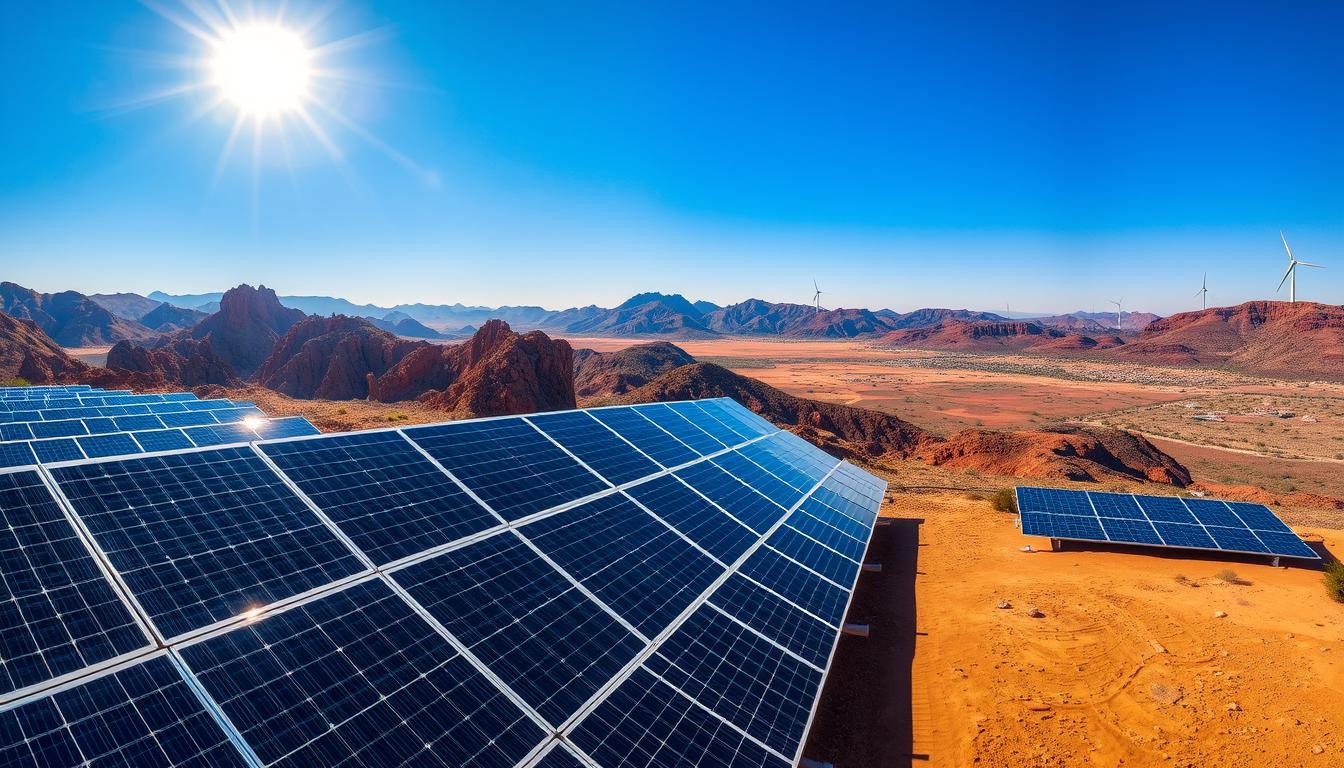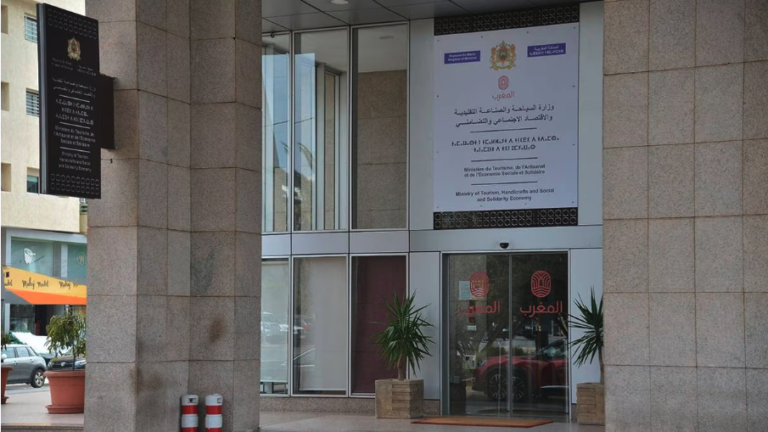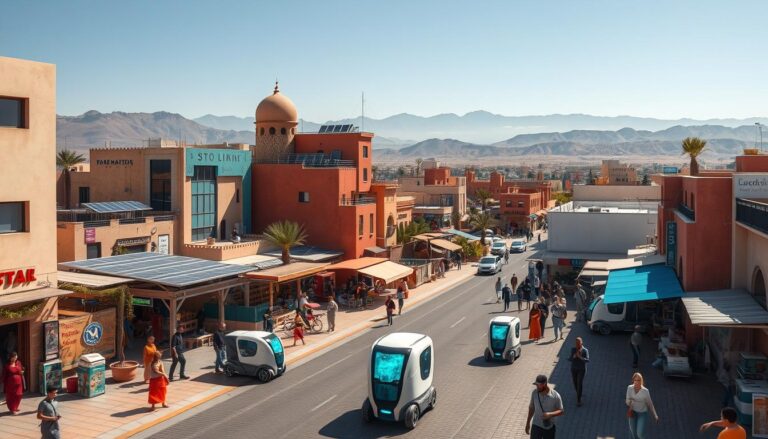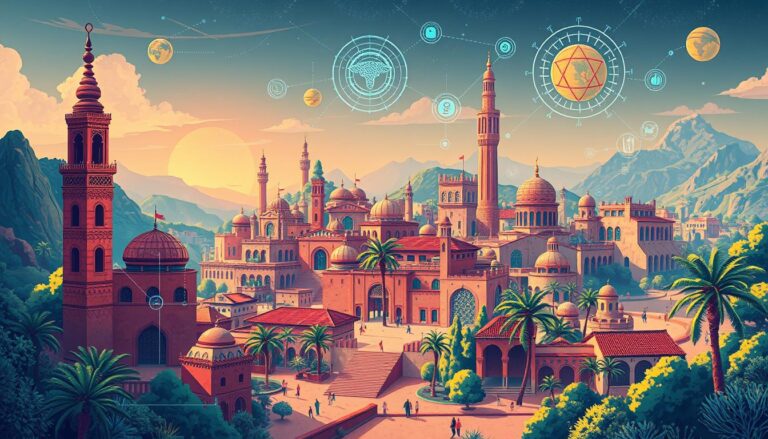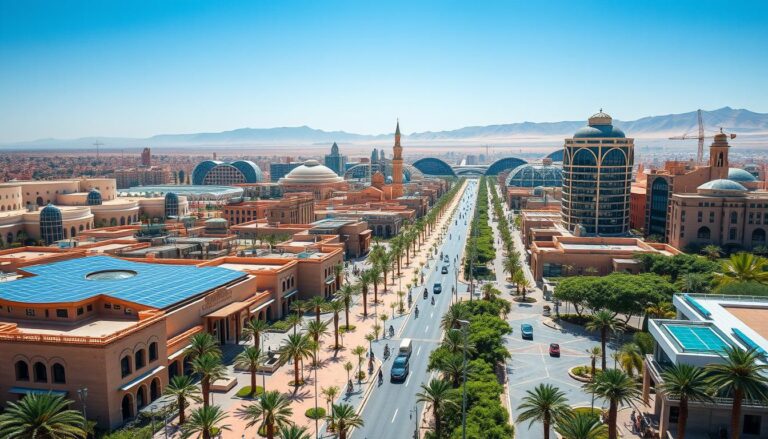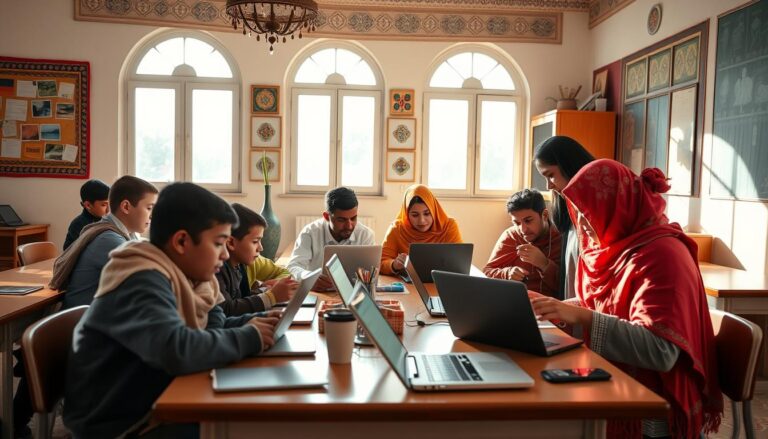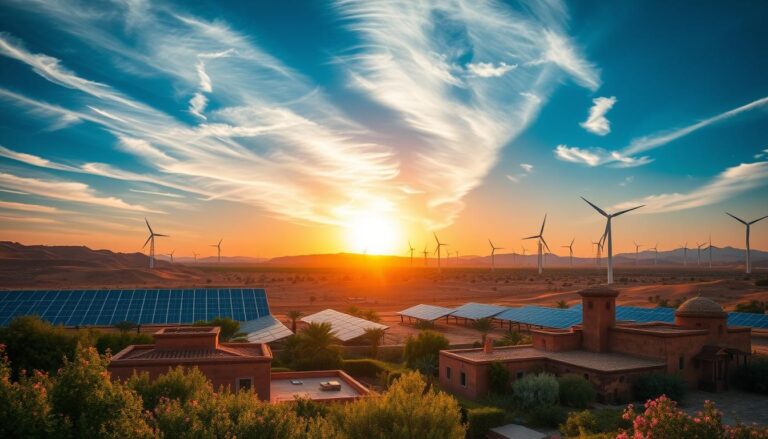Can a country heavily reliant on energy imports become a global leader in renewable energy? Morocco is on a bold path to find out. In 2022, it was still 90% dependent on energy from other countries. This shows how urgent its need for change is.
But Morocco sees a huge opportunity in clean energy. It could produce 500 terawatt hours of it every year. This includes 350 terawatt hours from wind and 150 terawatt hours from solar.
This vision puts Morocco at the top of renewable energy in the region. It aims to get 52% of its electricity from clean sources by 2030.
Morocco is known for its innovative projects. The Ouarzazate Solar Power Station and wind farms are just the start. These plans not only change the energy mix but also create jobs and attract investments.
Exploring Morocco’s clean energy journey reveals its strategies and challenges. But it also shows the progress it’s making. This progress is an example for sustainable energy in North Africa.
Overview of Morocco’s Renewable Energy Goals
Morocco is working hard to meet its renewable energy goals. It wants to use more green energy by 2030. This effort is to make sure more people have electricity and to use cleaner energy.
Goals and Targets
Morocco aims to change its energy use in big ways. It has set clear targets for renewable energy. These goals include:
- Generating 8 percent of primary energy from renewable sources by 2012.
- Achieving 52 percent of electricity generation from renewables by 2030.
- Expanding hydropower capacity, which constituted 24 percent of the installed capacity by 2008.
- Developing 4,000 MW of solar power by 2030 as part of the Moroccan Solar Plan (NOOR).
They also plan to increase wind power. The Tarfaya wind farm is a big part of this, with 301 MW of power.
Climate Change Performance Index
Morocco is doing well in fighting climate change. It has invested a lot in green energy. This shows its commitment to the planet.
Morocco wants to lead in green energy. It has already made good progress. By 2021, 37.08 percent of its electricity came from renewables. They aim to do even better.
The Ouarzazate Solar Power Station
The Ouarzazate Solar Power Station is a key project for Morocco’s clean energy goals. It covers 3,000 hectares and is a big step towards using solar power. This project can power a million homes, which is like powering the cities of Prague or Marrakech.
Phases and Development
The Ouarzazate Solar Power Station was built in several stages:
- Noor I: Finished in February 2016, it spans 450 hectares. It uses half a million mirrors and has 160 MW capacity. It can produce 370 GWh yearly and cost $3.9 billion. It also created over 2,000 jobs, with 85% for Moroccans.
- Noor II: This phase has 200 MW capacity and uses parabolic mirrors. It covers 680 hectares and can store electricity for 7-8 hours. The cost was over MAD 9 billion.
- Noor III: It’s a 150 MW project with a seven-hour storage system. It covers 550 hectares and can produce 500 GWh yearly. It shows Morocco’s commitment to clean energy.
- Noor IV: The last phase is a 72 MW photovoltaic power station. It cost $83 million.
Investment and Output
The total cost of the Ouarzazate Solar Power Station was about $9 billion. It was funded by international sources like the German KfW and the World Bank. The area gets a lot of sun, making it perfect for solar power.
The Noor complex can produce a lot of power. Noor I, II, and III together have a 510 MW capacity. Noor I produces 370 GWh, Noor II 600 GWh, and Noor III 500 GWh yearly. Morocco aims to increase its renewable power by 10 GW by 2030.
Wind Power in Morocco
Morocco is leading the way in renewable energy, especially in wind power. This North African country is using its good wind conditions to increase its clean energy. It’s working towards a sustainable future.
Onshore Wind Potential
Morocco has a lot of potential for onshore wind, with a capacity of 25 GW. By 2022, wind power made up 13.48% of the country’s electricity. Places like Tanger and Tetouan have very high wind speeds, perfect for wind farms.
The country aims to add 6 GW of wind capacity by 2030. This shows its strong commitment to renewable energy.
Key Wind Farm Projects
The Tarfaya wind farm is a standout, with a load factor of 45%. It’s one of the best in the world for onshore wind. By 2022, Morocco’s wind capacity grew to 1,788 MW, making it Africa’s second largest.
Projects like Amogdoul and Khalladi Wind Farms have been key to these successes. They show Morocco’s progress in wind energy.
These projects also involve international partnerships. Companies like Enel Green Power and Masen are leading the way. They help reduce 326,000 tons of carbon dioxide emissions every year.
Siemens Gamesa Renewable Energy provided 50 SWT-DD-130 turbines, each with a 4.2 MW capacity. These efforts are backed by long-term power purchase agreements with ONEE. This shows Morocco’s commitment to using wind resources for a sustainable future.
Sustainable Energy Development in North Africa
North Africa is leading the way in sustainable energy, with Morocco and Egypt at the forefront. Morocco’s $219 million clean energy park in Oujda is a key project. It encourages private investment and supports renewable energy companies.
Solar energy is crucial in North Africa. The region’s solar panels make up to three times more energy than those in Europe. Projects like Morocco’s Noor and Egypt’s Benban solar farms are among the largest globally.
The Xlinks project in Morocco is a $22 billion effort. It plans to use solar and wind energy. It aims to power over 7 million British homes by 2030.
Egypt’s Benban solar park near Aswan is a fast-executed project. It finished its 1,650-megawatt facility in just two years. This shows North Africa’s quick progress in sustainable energy.
The European Commission’s REPowerEU plan is key for North Africa. It aims to reduce Europe’s Russian fossil fuel use. Morocco’s power pool could send green electricity to West Africa, boosting eco-friendly solutions.
North Africa is a leader in wind and solar projects. It has nearly half of Africa’s wind power and a fifth of its solar power. These projects create jobs, offering more opportunities than fossil fuels.
Public finance is the main funding for renewable energy projects. Investments peaked at USD 5.7 billion in 2017 but fell to USD 2.4 billion in 2021. Morocco and Egypt focus on sustainable energy, showing North Africa’s leadership.
Sustainable energy initiatives in North Africa set a precedent for the rest of the continent, driving the global green agenda forward.
Solar Energy Projects Across Morocco
Morocco is a leader in renewable energy, especially in solar projects. The country has big goals and is taking bold steps to achieve them.
Solar Insolation Rates
Morocco’s high solar insolation rates are key to its solar success. The country gets a lot of sunlight, perfect for big solar projects. The Ouarzazate Solar Power Station, or Noor complex, is a great example of this.
These high insolation rates help Morocco meet its renewable energy targets. By 2030, 52% of its electricity will come from renewables, with 20% from solar. This shows how important using Morocco’s solar resources is.
MASEN and Solar Initiatives
The Moroccan Agency for Solar Energy (MASEN) is crucial for solar projects in Morocco. It’s a partnership between the public and private sectors. MASEN helps projects like the Noor complex grow, adding to the national grid.
Thanks to MASEN, Morocco is a leader in solar energy. A new 1,600 megawatt solar plant in Midelt province shows Morocco’s long-term solar plans.
In short, Morocco’s high solar rates and MASEN’s direction have boosted solar projects. This shows Morocco’s dedication to a sustainable energy future.
Green Technology Projects and Innovations
Morocco is quickly becoming a leader in green technology. It’s making big strides in research and development. This is thanks to its university projects and new solar technologies.
University Research and Development
University research in Morocco is key to its green tech growth. Professors like Abdelkader Otzogit lead teams. They’re making advanced solar cells from local, affordable materials.
This focus on research is driving innovation. It shows Morocco’s ability to use natural resources wisely.
Innovative Solar Technologies
Solar tech is at the heart of Morocco’s renewable energy plans. The cost of solar cells has dropped thanks to global investment. Noor Ouarzazate is a big success story.
It shows how solar tech can help families save money and use energy better. These projects are attracting attention from around the world. They highlight the value of Morocco’s solar innovations.
Eco-Friendly Power Solutions and Technology
Morocco is leading the way in eco-friendly power solutions and clean energy technology. The country aims to get 52% of its power from renewable sources by 2030. This includes 20% from solar, 20% from wind, and 12% from hydro energy.
The government is investing heavily in energy technology research and development. This is crucial for reaching these ambitious targets.
The Institute for Research in Solar Energy and New Energies (IRESEN) is key to Morocco’s green technology drive. IRESEN funds research projects on renewable energy and eco-friendly solutions. This shows Morocco’s focus on innovation in clean energy.
Morocco has made great progress in renewable energy. By 2020, 42% of its electricity came from renewables. The country also made huge strides in electricity access, reaching 99.43% in 2018.
The Noor Ouarzazate Solar Complex and Tarfaya wind facility are major projects. They show Morocco’s dedication to eco-friendly energy.
Morocco plans to double its investment in clean energy research to 80 million € by 2023. This will help green technologies grow. Morocco is becoming a leader in solar and thermal energy systems.
Morocco’s efforts in eco-friendly power are a beacon of sustainability. With big investments and a strong plan, Morocco is on track to meet its renewable energy goals. It’s setting an example for other countries.
Morocco’s National Renewable Energy and Efficiency Plan
Morocco launched its National Renewable Energy and Efficiency Plan in 2008. It aims to change the country’s energy scene. This will boost the economy and make it more sustainable.
Plan Overview
The plan has a big goal: to reach 42% in renewable energy. Right now, they’re at 42%. By 2030, they want to get over half of their power from green sources.
They plan to add 9 gigawatts to their power. 7GW will come from renewable energy. This will help them use less imported fossil fuels and tap into their natural resources.
Investment and Job Creation
The plan needs a lot of money to work. The government is putting in $9 billion for renewable energy projects. They also have $4 billion for gas projects.
This big investment will create jobs in Morocco. It will help the renewable energy sector grow. Morocco is already a leader in green technology in the area.
The plan does more than help the environment. It also boosts the economy. It does this through big investments in renewables and creating jobs in Morocco. It’s leading the country to a greener and wealthier future.
Challenges and Criticisms
Morocco’s clean energy projects have won praise worldwide. Yet, they face several challenges and criticisms. One major issue is the focus on big projects. Critics say this might overlook smaller, community-based efforts.
They worry that big projects could favor foreign investors over local people. For example, the Ouarzazate Solar Power Station is a big deal. But, there’s concern that local folks might not get as much benefit as expected.
Focus on Mega-Projects
Big renewable energy projects have their good sides and bad sides. On the plus side, they can generate a lot of power. This helps Morocco aim for 52% of its electricity to come from renewables by 2030.
But, focusing too much on these big projects might overlook smaller, local efforts. These smaller projects could have a bigger impact right away. Also, critics say these big projects might help foreign companies more than Moroccans. This is because a lot of the investment and profits might come from outside.
It’s important to balance big projects with smaller ones. This way, Morocco can grow its renewable energy in a more complete way.
Water Resource Concerns
Water is another big issue. Big solar projects need a lot of water for cooling and cleaning. Morocco’s dry climate and water scarcity make this a big worry for environmentalists and locals.
It’s crucial to find ways to use less water in these projects. This could involve using new, water-saving technologies. This way, Morocco can keep moving forward with renewable energy without harming its water resources.
In short, Morocco’s push for renewable energy is great for the future. But, it’s important to tackle the challenges these projects face. By finding a balance and being careful with resources, Morocco can make its energy transition work for everyone and the planet.
Source Links
- Morocco: New Prospects for Clean Energy Development
- Morocco – Energy
- Renewable energy in Morocco
- Morocco’s National Energy and Energy Efficiency Plan | Inequality Solutions
- Four Reasons Why Morocco Is Becoming a Renewable Energy Powerhouse
- Investment Opportunities in Morocco’s Energy Sector
- Noor Ouarzazate: the world’s largest concentrated solar power plant built in Morocco
- Ouarzazate Solar Power Station
- Wind power in Morocco
- Power plant profile: Midelt Wind Farm, Morocco
- In Scramble for Clean Energy, Europe Is Turning to North Africa
- North Africa’s Renewable Potential and Strategic Location Reinforce Its Role in Energy Transition
- How Morocco went big on solar energy
- Moroccan Farmers Compete with Solar Complexes for Access to Dwindling Water Resources – Institute for Middle East Studies
- A shining example of green energy in Morocco
- Morocco
- Plans and priorities – Mission Innovation
- Morocco’s path to a climate-resilient energy transition: identifying emission drivers, proposing solutions, and addressing barriers
- Why Morocco is emerging as Europe’s renewable-energy partner of choice
- Morocco reveals strategy to speed up energy transition | AGBI
- CLEAN TECHNOLOGY FUND
- Just Energy Transitions? Lessons From Oman and Morocco
- Morocco’s sustainable energy transition and the role of financing costs: a participatory electricity system modeling approach – Energy, Sustainability and Society
- Green energy security assessment in Morocco: green finance as a step toward sustainable energy transition

The Editorial Team is a passionate group of Morocco enthusiasts dedicated to sharing the beauty, culture, and wonders of this captivating country. With diverse backgrounds and a deep love for travel, we strive to bring you engaging and informative content that inspires your Moroccan adventures. From uncovering hidden gems and sharing local insights to exploring mouthwatering cuisine and showcasing the vibrant lifestyle, our team is committed to providing you with valuable resources and exciting stories that enhance your exploration of Morocco. Join us on this journey as we celebrate the rich heritage and unforgettable experiences that make Morocco truly special.

